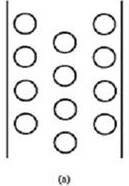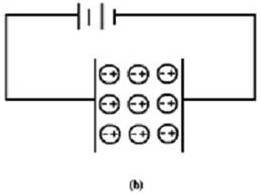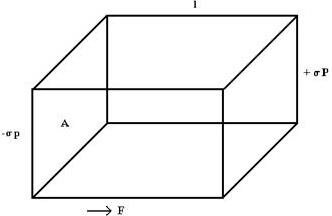This article has been authored by Prashant Sharma, a Technology Columnist-Engineer by Profession who has scripted a cluster of Utility focussed and simplistic write-ups relating to Physics out here.His fundamental striking articles at XAmplified are easy-to-understand and helpful enough for Physics-phobic folks
Table Of Content
Definition
A dielectric is a material which contains no free electrons, so that no current can flow through them. As a result, the electrical conductivity of a dielectric is poor and for an ideal dielectric it comes out to be zero.
Introduction
According to band theory of solids, a dielectric is a material in which the energy band gap between valence and conduction band is more 3 eV. Glass, plastic, mica etc. are examples of dielectrics. When a polar or non-polar molecule is placed in an external electric field, the small displacements of the orbital-electrons cause the distance between the centers of gravity to alter. Thus non-polar molecules become induced dipoles whereas polar molecules, which are already dipoles, will be oriented by the field and may have resultant dipole moment modified, since they possess (1) permanent dipole moment and (2) induced dipole moment. The phenomenon of the orientation of the induced dipole along the lines of force is called Electric polarization.


(a) Non-polar molecules are represented as sphere.
(b) Induced dipoles are shown to be aligned along lines of force.
Electric vectors
Electric intensity (E)
The Electric field Intensity at any point in an electric field is defined as the force experienced per unit infinitesimal positive charge (q0). If ‘F’ is the force on small charge q0 then,
That is,
![]()
This direction of E is along the direction of force. The unit E is Newton / Coulomb or Volt / m.
Electric polarization
When a dielectric is placed in an external field, its molecules gain electric dipole moment and the dielectric is said to be polarized. The electric dipole moment induced per unit volume of the dielectric material is called the Electric polarization of the dielectric. It is represented by a vector ‘P’.

Consider a rectangular block of the polarized dielectric of length I and uniform cross – sectional area A. Let surface charge densities of fictitious charges appearing at the end faces by +σp and -σp.
Therefore, The charge induced on each face = σp A
Total induced electric dipole moment = -qI = σp AI
Volume of block = AI
Therefore, Induced dipole moment per unit volume
![]()
By definition, this is the polarization,
Therefore polarization P = σp …. (1)
Thus the polarization may also define as ‘the surface density to charge appearing at faces perpendicular to the direction of applied field’.
Electric Displacement Vector ‘D’
Let us consider the polarization of a dielectric slab placed between the plates of parallel plate capacitor.
Let σfree be the surface density of free charge on capacitor plates and σp that of bound or polarization charges. The electric field strength due σfree and σp are given by
![]()
These are oppositely directed
The net electric field with in the dielectric is

But surface charge density σp is equal to polarization.
That is, σp = P
Therefore equation (3) gives
![]()
The above quantity is of special significance and is called the electric displacement vector D. That is,
![]()
Comparing (4) and (5), we get
D = σfree
Equation (5) represents relation between electric vectors D, E and P.
- D is connected with free charge only, so that it is not altered by the introduction of the dielectric.
- P is connected with the polarization charge only. It is also possible to represent this vector field by lines.
- E is connected with all charges that are actually present, whether free or bound. The lines of E indicate the presence of both kinds of charge.

Gauss’s law in Dielectrics
The surface integral of displacement vector over a closed surface is equal to the net free charge enclosed with in surface i.e.
![]()
The above equation is justified as follows:
When a dielectric is placed in an electric field there are two possibilities.
- The molecules of some dielectrics, like water, have permanent electric dipole moments. Such dielectrics are called polar dielectrics.
- The electric field tends to separate the negative and positive charges in the atoms or the molecules of the dielectric whether or not the atoms or molecules have permanent electric dipole moments. Thus an induced electric dipole moment is produced in the atoms or the molecules of the dielectric when placed in an electric field.
Consider a parallel plate capacitor filled with a dielectric of per permittivity ε carrying a fixed charge +q and –q to provide a uniform external electric field. The function of the electric field is to separate the centre of the positive charge of the dielectric slightly from the centre of the negative charge.
Thus the applied electric field induced positive and negative charge in the dielectric, in such a way that the electric field set up by them opposes the external electric field. As the dielectric as a whole remains electrically neutral, the positive induced surface charge must be equal to the negative induced surface charge.
Let E0 and be the electric field in the absence and the presence of the dielectric between the plates respectively.
If no dielectric is present, Gauss’s law for a closed surface given

If the dielectric is present, then net charge enclosed by Gaussian surface is q –q`, q` being induced charge due a polarization and so Gauss’s law gives.

But we have,

Using (1), we get
![]()
Comparing (3) and (5), we get
![]()
Or induced charge
![]()
Obviously induced charge q` is always less in magnitude than the free charge q and is equal to zero if no dielectric is present. From (6)
![]()
Substituting this in (2), the Gauss’s law in dielectric takes the form.

This is Gauss’s law for dielectrics. In other words, the surface integral of displacement vector ‘D’ over a closed surface is equal to the free charge enclosed within the surface.
